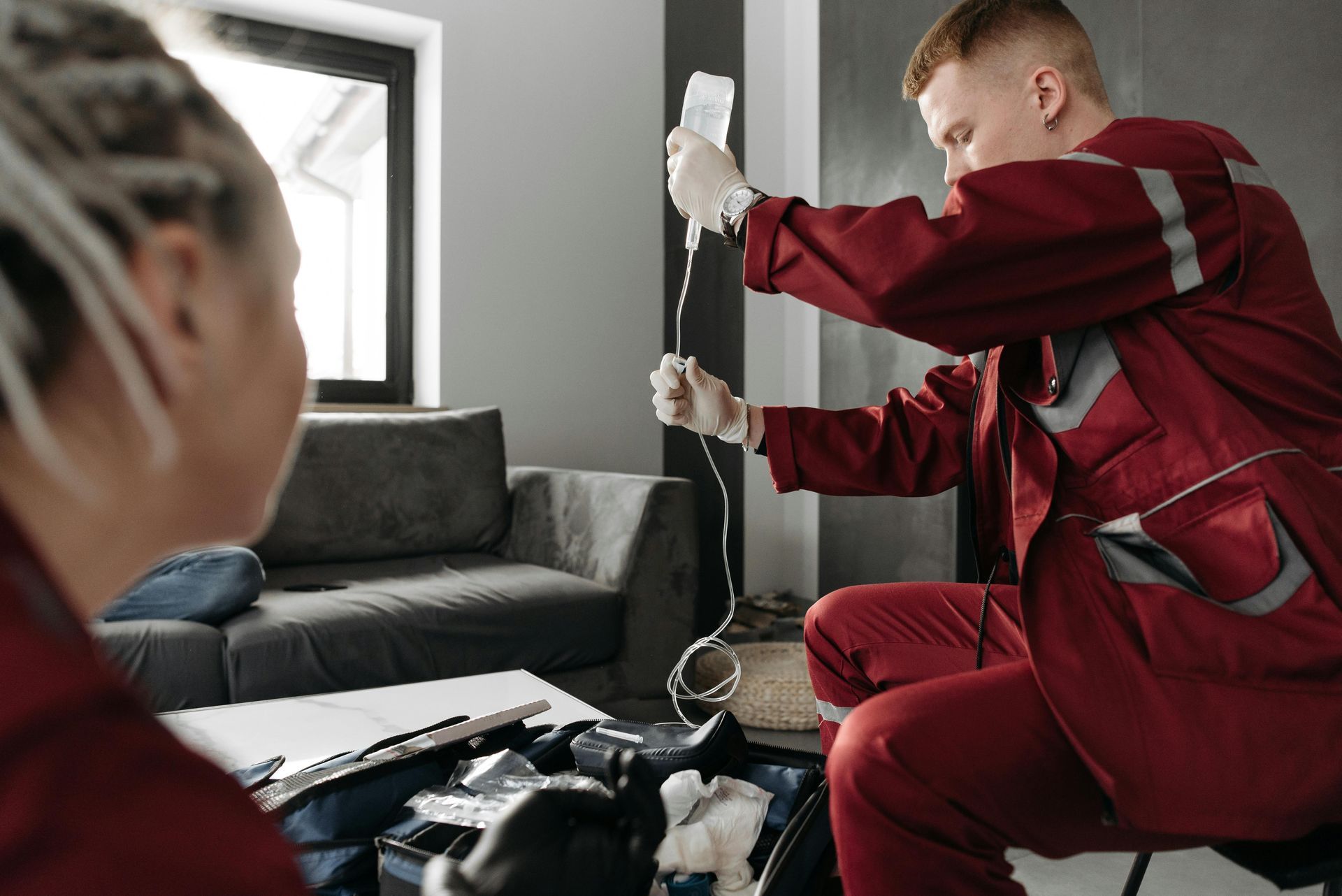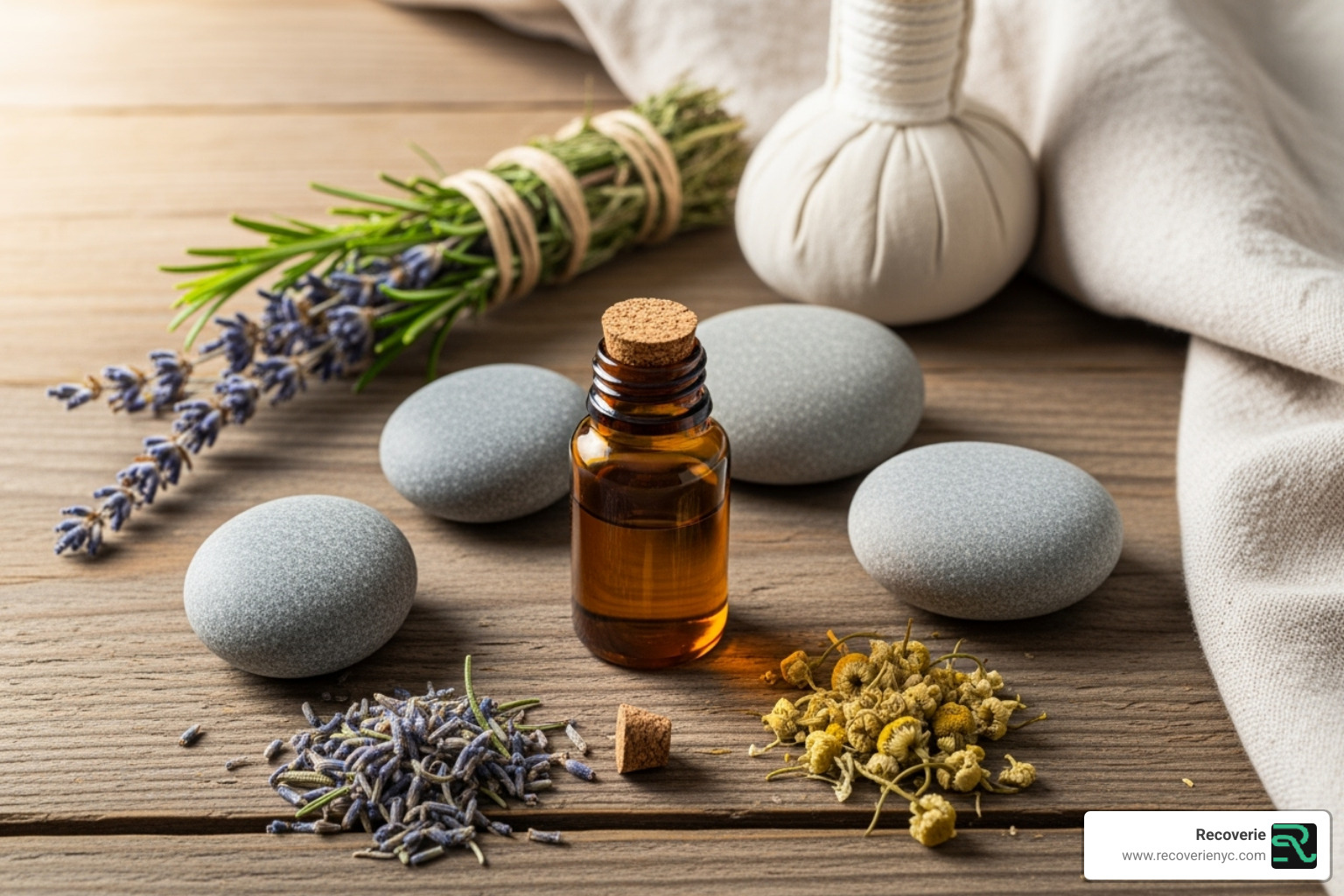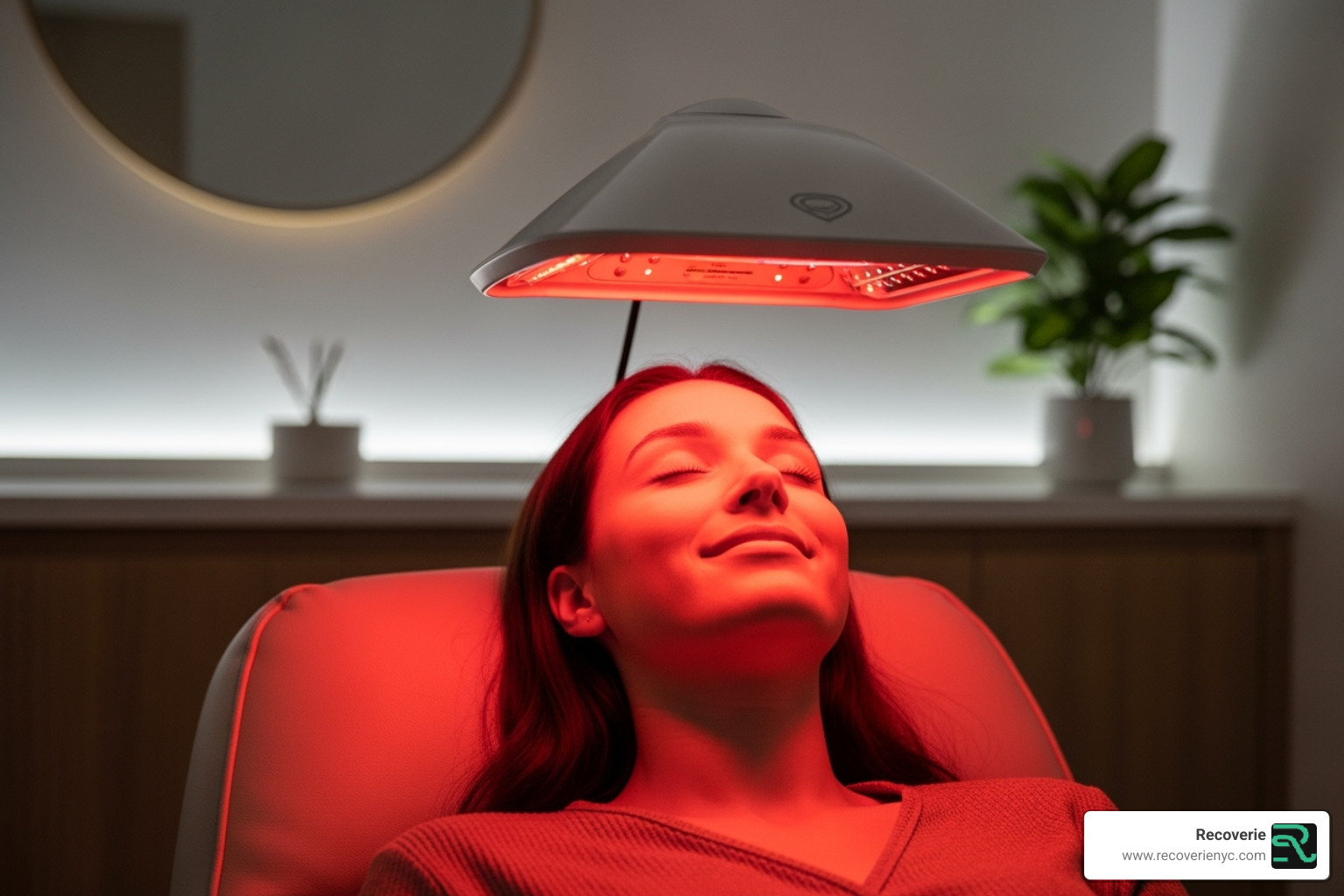Beyond the Chill: Exploring the Full Spectrum of Cold Therapy Advantages
What is Cold Water Immersion?
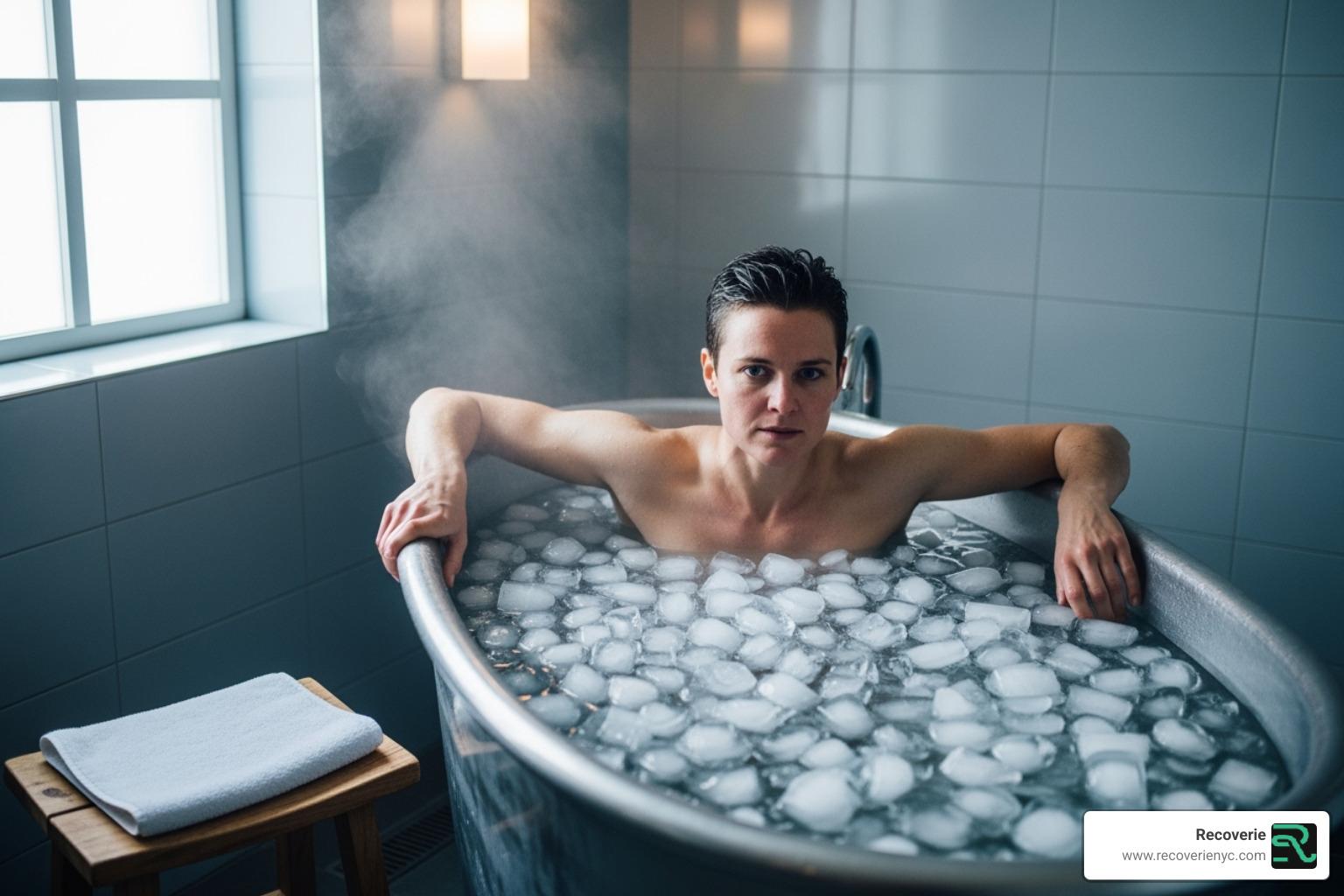
Ice bath benefits have captured the attention of athletes and wellness enthusiasts alike. But what happens when you immerse yourself in freezing water?
Quick Answer: Key Ice Bath Benefits
- Physical Recovery : Reduces muscle soreness and inflammation.
- Mental Health : Boosts mood, alertness, and stress resilience.
- Immune Support : Strengthens immune function.
- Circulation : Improves blood flow and metabolism.
Cold water immersion (CWI), or ice bathing, involves submerging your body in 50-59°F (10-15°C) water for 2-15 minutes. This triggers physiological responses that benefit the body and mind.
The science is simple: cold water constricts blood vessels (vasoconstriction), pushing blood to your core. When you exit, they expand (vasodilation), flooding tissues with oxygen-rich blood. This process, with the water's hydrostatic pressure, creates the recovery benefits.
Popularized by athletes like LeBron James and Michael Phelps , this practice is accessible to everyone. As one fitness instructor noted: "I’m literally so amazed at the ice bath every time. Like how every ache is just gone."
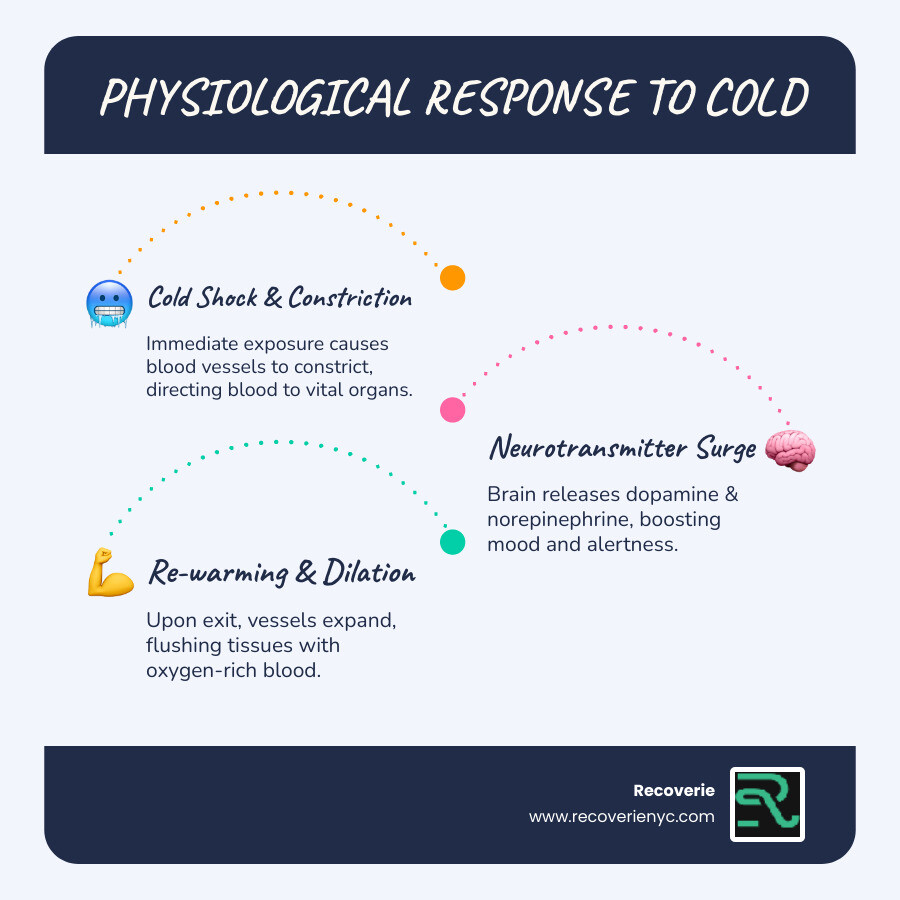
The Physical Edge: Unpacking the Ice Bath Benefits for Your Body
Physical recovery is one of the most well-known ice bath benefits . The cold water triggers specific physiological responses that significantly aid our bodies after physical activity.
Easing Sore Muscles and Accelerating Recovery
Ice baths are renowned for combating Delayed Onset Muscle Soreness (DOMS). Immersion in cold water causes vasoconstriction, which limits the inflammatory response and reduces swelling. Upon exiting, vasodilation flushes out metabolic waste, bringing fresh, oxygen-rich blood to your tissues.
A review of 32 randomized controlled trials found that cold-water immersion one hour after exercise helped reduce muscle pain and improve recovery for up to 24 hours. While a small 2017 study suggested cold dips are as effective as low-intensity exercise, many professionals agree that ice baths aid the central nervous system, leading to improved muscle power and a quicker return to peak form. For more about soothing sore muscles, consider exploring various recovery methods.
Boosting Your Immune System
Research indicates that consistent cold exposure can increase white blood cells, which are crucial for fighting infections. In fact, people who practice cold-water swimming have shown 40% lower incidence rates of respiratory tract infections. A notable 2016 study found that people who switched to cold showers called in sick 29% less often, underscoring how cold exposure can improve immune activity.
Enhancing Metabolic Health and Circulation
Cold exposure can also rev up our metabolism. To maintain core temperature, the body works harder, which can activate brown fat—a type of fat that burns calories to generate heat. This is advantageous as brown fat decreases with age. The vasoconstriction and vasodilation cycle also improves overall blood flow, delivering oxygen and nutrients more efficiently throughout the body.
A Clearer Mind: The Surprising Mental Health Perks of Cold Plunges
The ice bath benefits for your mind can be even more powerful than the physical ones. The intense shock of cold water is precisely what makes it a game-changer for mental health. Each time you step into the cold, you're training yourself to stay calm when things get uncomfortable, a skill that pays off well beyond the bath.
One of the Key Ice Bath Benefits: Boosting Mood and Alertness
There's real science behind the post-plunge euphoria. Immersing yourself in cold water for just 2 minutes releases a massive surge of feel-good chemicals: a 260% increase in dopamine and up to 530% more norepinephrine .
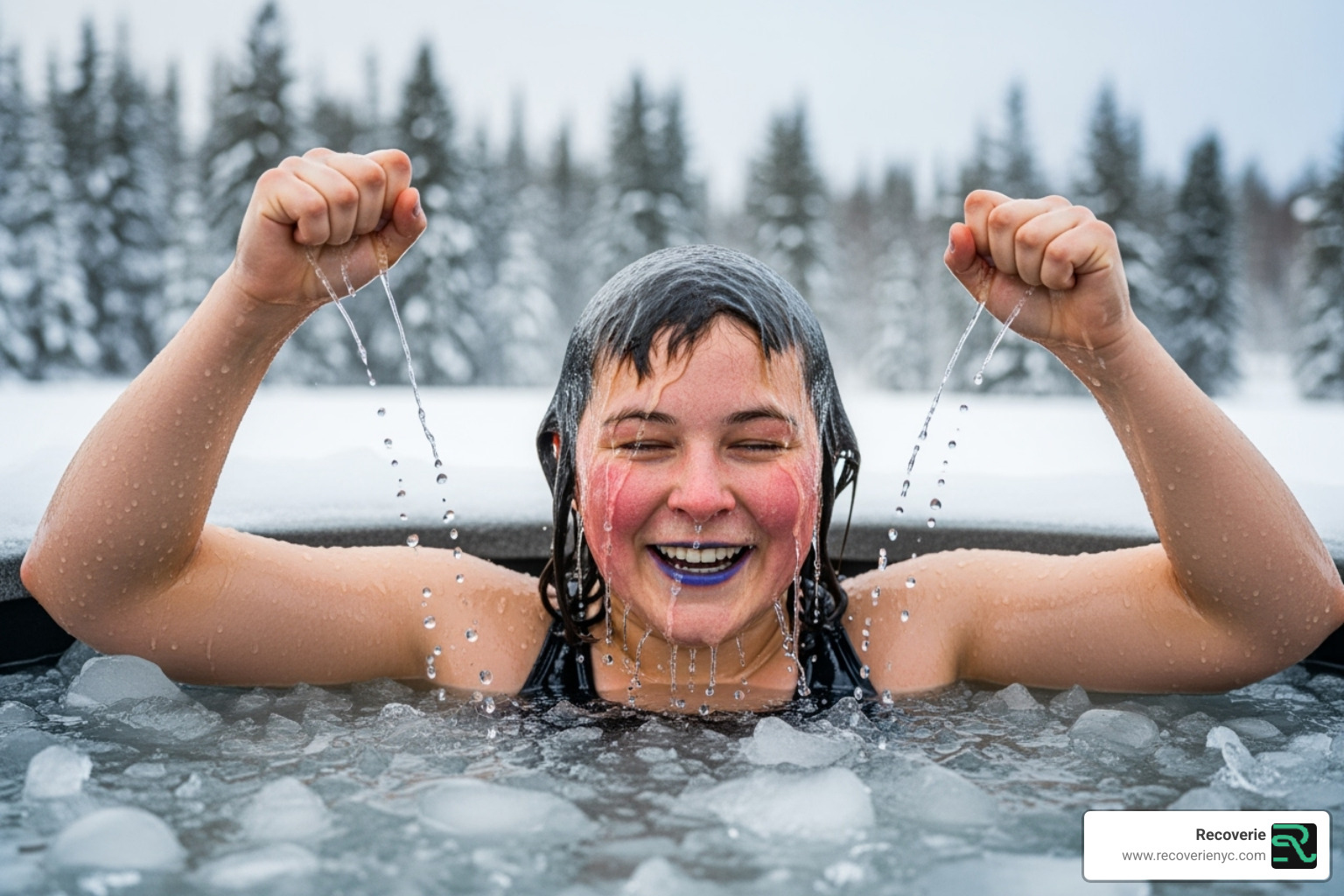
Dopamine is your brain's reward chemical, while norepinephrine sharpens focus. A 2023 study on improved mood states found participants felt more active, alert, attentive, proud, and inspired after just five minutes in cold water, noting significant improvements in combating brain fog and depression symptoms. It's like hitting a reset button for your nervous system.
Training Your Body's Stress Response
By voluntarily stepping into cold water, you teach your nervous system to handle discomfort. While the initial cold exposure activates your sympathetic (fight-or-flight) response, cortisol reduction occurs for up to three hours post-plunge, meaning stress hormone levels drop.
The cold also provides powerful vagus nerve stimulation . Your vagus nerve helps you shift from stressed to calm. Research shows that regular cold exposure strengthens this nerve, making you more resilient to daily stressors. This mental fortitude transfers to everything else, helping you feel more composed during life's challenges.
The Science Behind the Shiver: What Research Says About Ice Baths
The research on ice bath benefits is complex, with some conflicting findings . Many studies have limitations , such as small sample sizes or focusing only on elite athletes versus the general population . This ongoing debate keeps experts like Dr. A. Brion Gardner and Dr. Andrew Huberman actively discussing the nuances of cold water immersion.
The Debate: Muscle Gain vs. Recovery
One controversy is whether ice baths hinder muscle growth. If building muscle mass is your goal, timing matters.
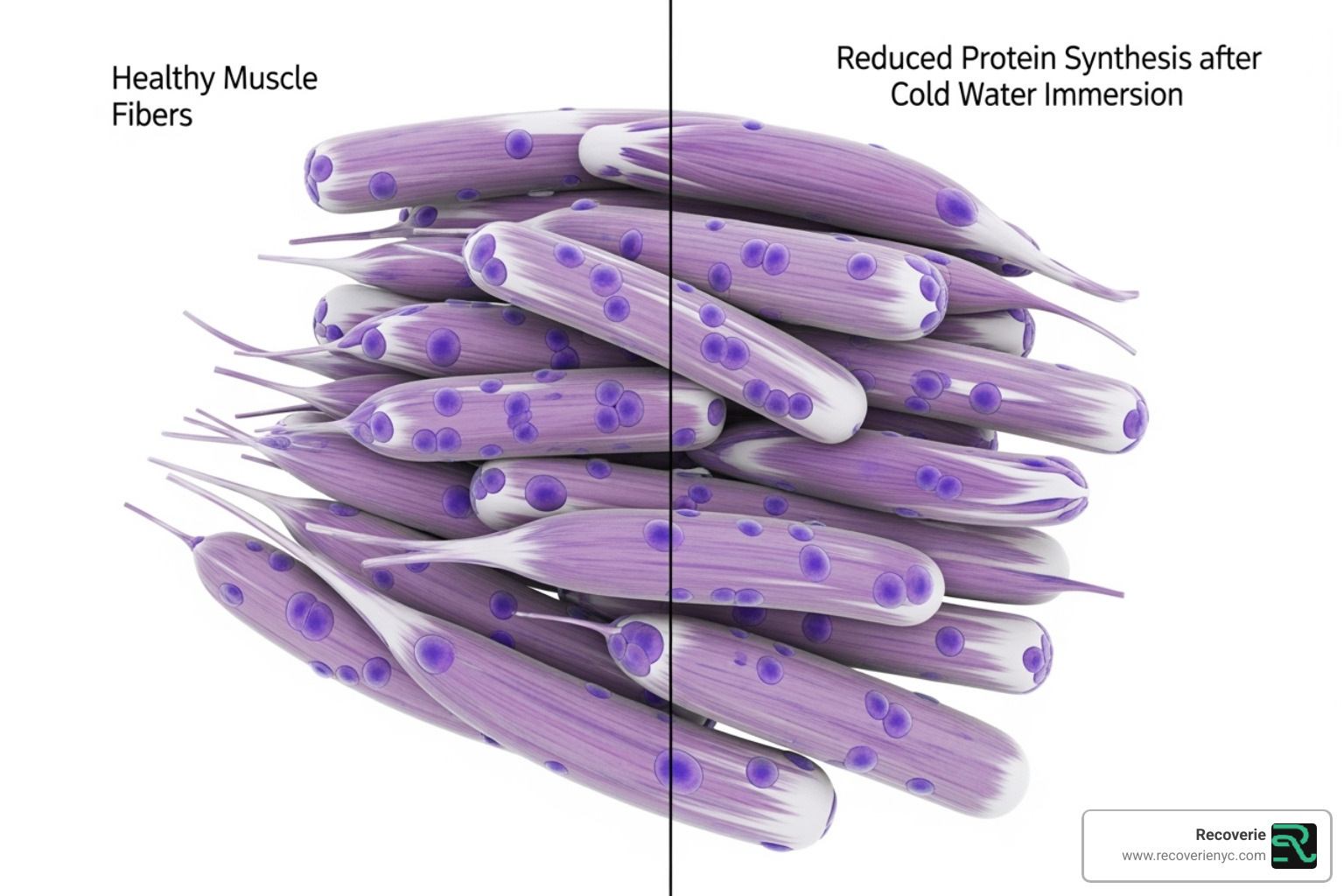
A 2019 study suggested that CWI might hinder muscle protein synthesis . This has led some experts to recommend waiting 6-8 hours after a strength workout before plunging. Ice baths seem to excel for endurance training recovery but may interfere with strength adaptations. For many, this trade-off isn't a deal-breaker, and active recovery methods can be equally effective.
The Consensus on Key Ice Bath Benefits
Despite debates, there's solid agreement on several core benefits. The reduced perception of pain is well-documented. A systematic review on reducing muscle soreness supports using ice baths for DOMS. One of the most reliable benefits is lowering core body temperature quickly, which is valuable for athletes in hot conditions. The benefits for acute recovery and the psychological effect of building mental resilience are also widely recognized.
Your Guide to Taking the Plunge: Safety, Risks, and Best Practices
While the ice bath benefits are enticing, it’s crucial to approach cold water immersion with caution. Safety is the top priority, so understanding proper techniques, durations, and contraindications is essential.
How to Take an Ice Bath Safely
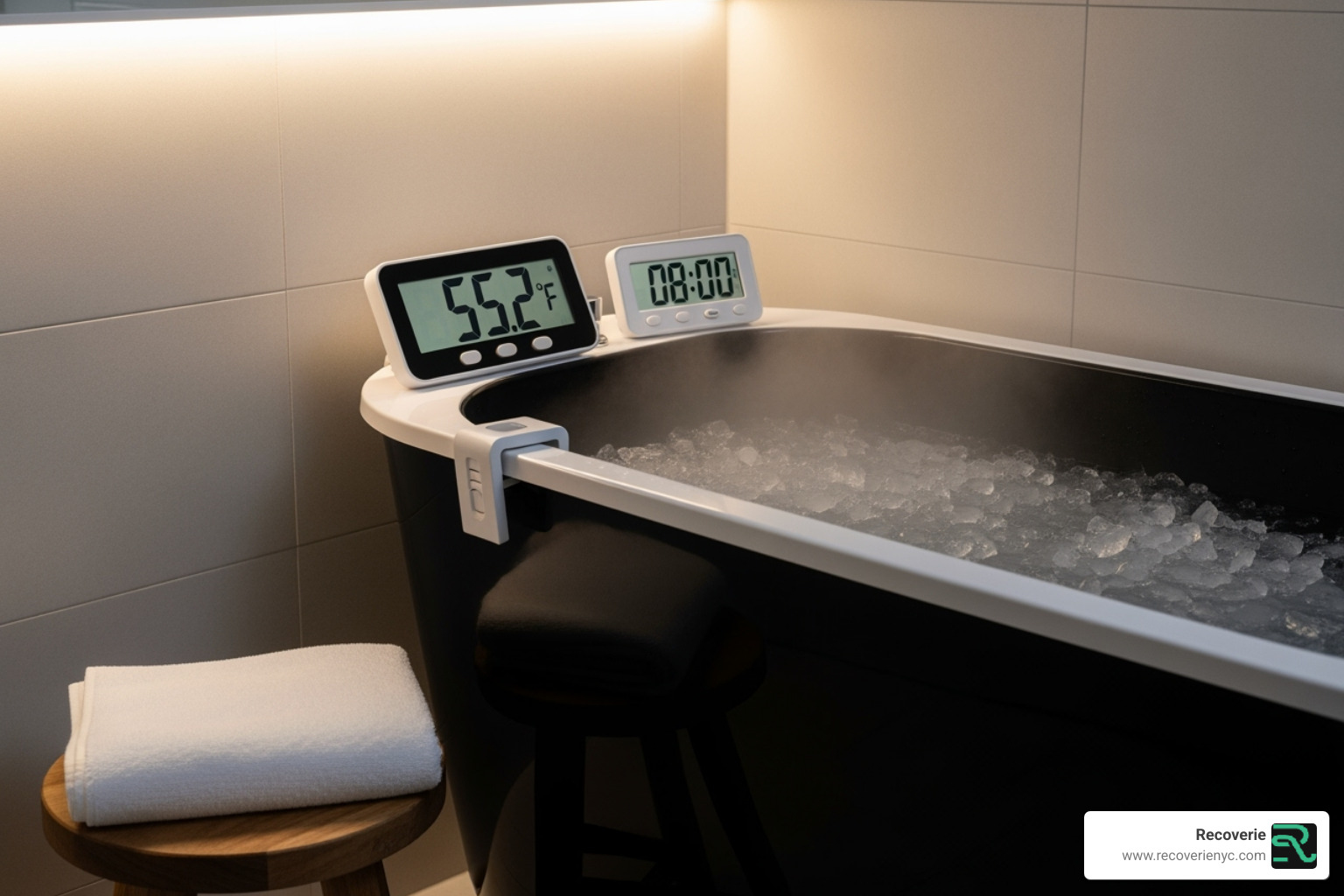
- Ideal Temperature: Aim for 50-59°F (10-15°C). Use a thermometer for accuracy.
- Recommended Duration: Beginners should start with 10-30 seconds, gradually working up to the recommended 5-15 minutes. Do not exceed 15 minutes to avoid hypothermia.
- Starting Slow: Acclimatize with cooler showers before trying a full bath. Start by immersing only your lower body.
- Technique: Submerge your body as quickly as is comfortable. Focus on slow, deep breaths to manage the cold shock.
- What to Wear: A swimsuit or light athletic clothing is fine. Gloves and socks can protect sensitive areas.
- Never Plunge Alone: Always have someone nearby, especially when you are new to the practice.
- Post-Plunge Protocol: Have warm towels, clothes, and a warm drink ready to rewarm your body immediately.
Potential Risks and Who Should Be Cautious
Be aware of the significant risks.
- Cold Shock Response: Sudden immersion can trigger an involuntary gasp and spikes in heart rate and blood pressure, which can be dangerous for those with heart conditions. In extreme cases, it can be fatal.
- Hypothermia: Staying in too long can cause a dangerous drop in body temperature (below 95°F / 35°C).
- Nerve and Skin Damage: Prolonged exposure can result in ice burn or frostbite.
- Cardiovascular Stress: The practice can be dangerous for individuals with pre-existing cardiovascular disease, high blood pressure, or a history of heart attack or stroke.
- Specific Health Conditions: People with Diabetes , Raynaud's Syndrome , Cold Urticaria , Circulatory Issues , or Open Wounds should be cautious. Certain Medications like beta-blockers can also affect your body's response.
It is paramount to consult a doctor before taking an ice bath , especially if you have any chronic conditions.
How Ice Baths Compare to Other Recovery Methods
Understanding how ice bath benefits stack up against other recovery options can help you make the best decision for your needs.
| Recovery Method | Duration | Temperature | Mechanism | Primary Use |
|---|---|---|---|---|
| Ice Baths | 2-15 minutes | 50-59°F (10-15°C) | Wet cold immersion, vasoconstriction/vasodilation | Muscle recovery, inflammation reduction |
| Whole Body Cryotherapy | 2-4 minutes | -200 to -250°F (-129 to -157°C) | Dry cold exposure | Systemic recovery, pain relief |
| Contrast Therapy | 15-20 minutes total | Hot: 100-104°F, Cold: 50-60°F | Alternating vasodilation/vasoconstriction | Improved circulation, injury recovery |
Ice Baths vs. Whole Body Cryotherapy
Whole Body Cryotherapy (WBC) exposes you to extremely cold, dry air for 2-4 minutes, while ice baths use wet cold for longer. Water conducts heat away from the body more efficiently, so a 50°F ice bath can feel more intense than colder cryotherapy. Accessibility and cost also differ; ice baths can be done at home, while cryotherapy requires specialized, expensive equipment. For more information about whole body cryotherapy , you can explore its specific benefits.
Ice Baths vs. Contrast Therapy
Contrast therapy alternates between hot and cold treatments, creating a powerful vasodilation and vasoconstriction pump effect. This can be particularly effective for injury recovery and improving circulation by flushing metabolic waste and delivering fresh nutrients. However, it requires access to both hot and cold facilities, making it less convenient than a simple ice bath. You can learn more about contrast therapy and how this alternating approach might fit into your routine. Your choice will depend on your goals, budget, and access to facilities.
Introduction: What is Cold Water Immersion?
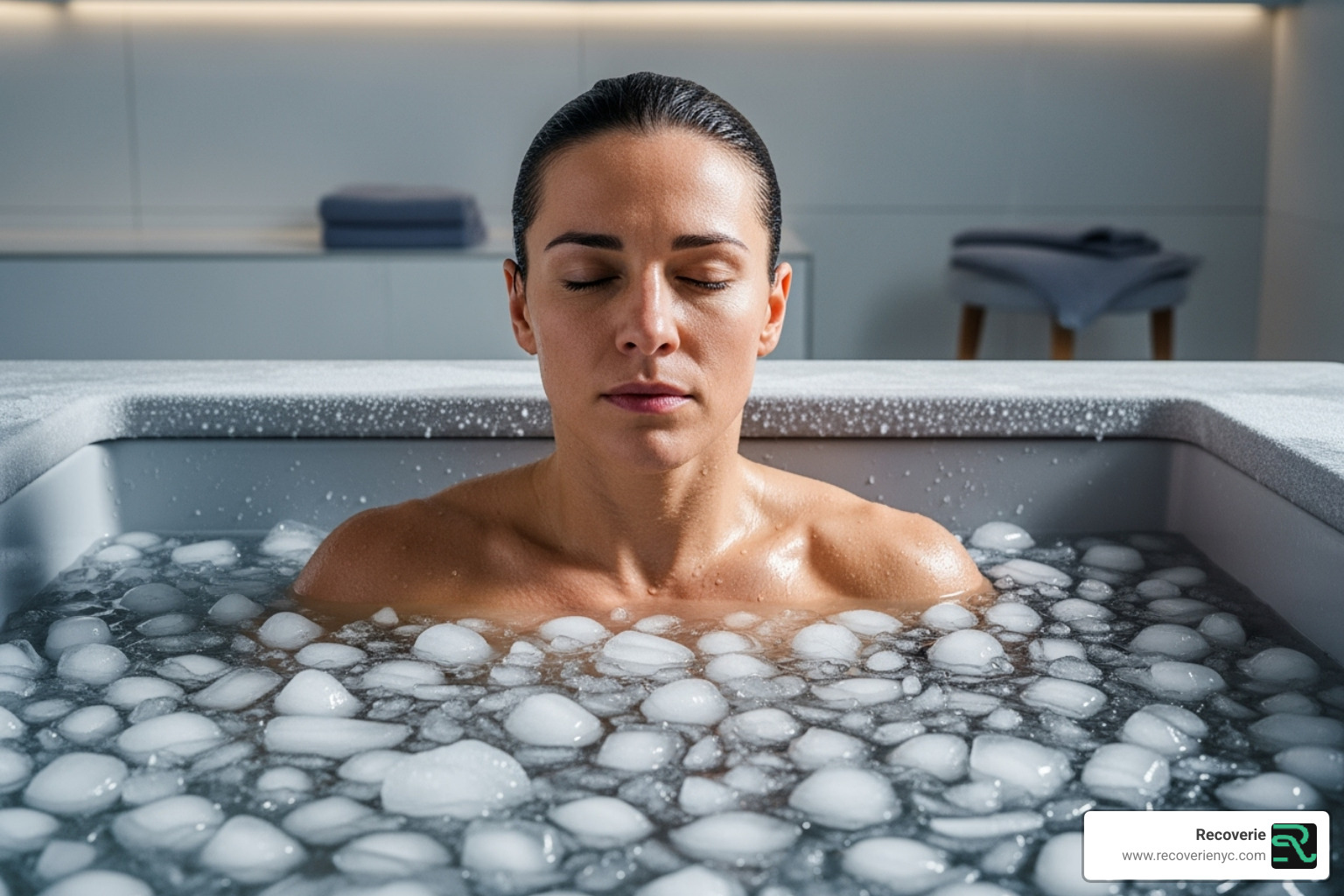
Ice bath benefits have captured the attention of athletes and wellness enthusiasts alike. But what exactly is cold water immersion?
Quick Answer: Key Ice Bath Benefits
- Physical Recovery : Reduces muscle soreness and inflammation.
- Mental Health : Boosts mood, alertness, and stress resilience.
- Immune Support : Strengthens immune function.
- Circulation : Improves blood flow and metabolism.
Cold water immersion (CWI), or ice bathing, involves submerging your body in 50-59°F (10-15°C) water for 2-15 minutes. The cold triggers vasoconstriction (narrowing of blood vessels), pushing blood to your core. Upon exiting, vasodilation (widening of vessels) floods tissues with oxygen-rich blood, aiding recovery.
Popularized by athletes like LeBron James and Michael Phelps , this ancient practice is accessible to everyone. As one fitness instructor noted: "I’m literally so amazed at the ice bath every time. Like how every ache is just gone."
The Physical Edge: Unpacking the Ice Bath Benefits for Your Body
When people hear about ice bath benefits , they often think of athletes. There's good reason for this, as the physical recovery advantages are remarkable. Your body's response to cold water is like a choreographed dance: blood vessels tighten, pushing blood to your core, then open wide upon exit, sending a rush of oxygen-rich blood to your muscles.
Easing Sore Muscles and Accelerating Recovery
For Delayed Onset Muscle Soreness (DOMS), ice baths shine. The cold acts as a natural anti-inflammatory, limiting swelling. When you get out, your body flushes out metabolic waste products that cause soreness. A review of 32 randomized controlled trials found CWI one hour after exercise reduced muscle pain and improved recovery for up to 24 hours. This translates to improved muscle power and getting back in the game sooner.
Boosting Your Immune System
Ice bath benefits also upgrade your immune system.
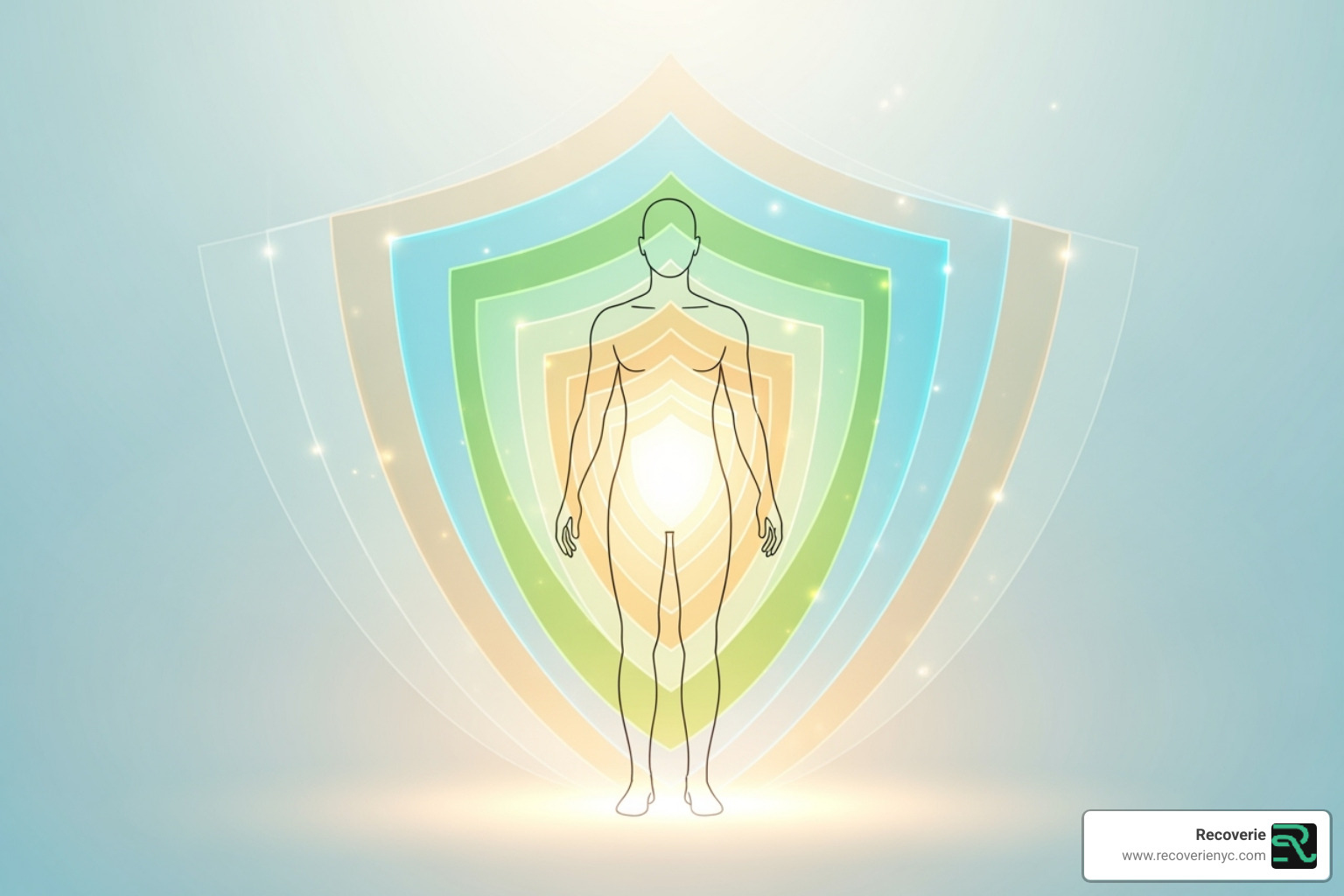
Regular cold exposure increases white blood cells, which fight infections. Cold-water swimmers show 40% fewer respiratory tract infections . A 2016 study on cold showers and sick days found people called in sick 29% less often , showing how even brief cold exposure strengthens your body's defenses.
Enhancing Metabolic Health and Circulation
Cold water can rev up your metabolism. Your body works to maintain its core temperature, activating brown fat—metabolically active tissue that burns calories for heat. Research on cold exposure and fat tissue shows this can help protect against obesity. The vasoconstriction-vasodilation cycle also improves overall blood flow, contributing to better cardiovascular health and vitality.
A Clearer Mind: The Surprising Mental Health Perks of Cold Plunges
While physical ice bath benefits get attention, the mental health advantages can be life-changing. The initial shock of cold water rewires your brain. Each time you immerse yourself, you practice controlled discomfort, building mental resilience that extends far beyond the bath itself.
One of the Key Ice Bath Benefits: Boosting Mood and Alertness
Just 2 minutes in water under 59°F (15°C) triggers a massive neurochemical response: dopamine levels can surge by 260% , while norepinephrine jumps by 530% . Dopamine is your brain's reward chemical, and norepinephrine sharpens focus, creating a natural high that can last for hours.
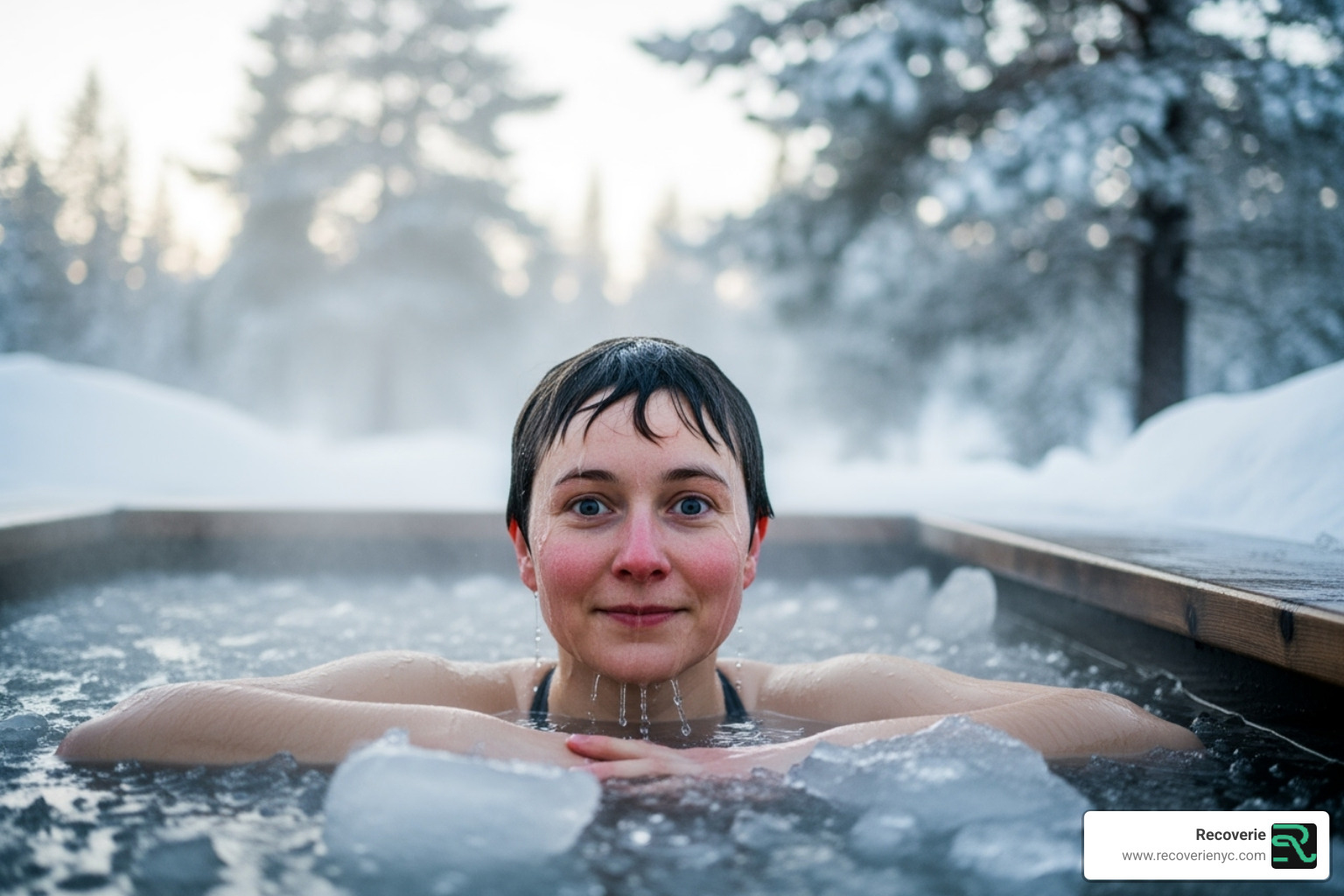
A 2023 study on improved mood states found that after five minutes in 68°F (20°C) water, participants felt significantly more active, alert, attentive, proud, and inspired . Regular cold exposure can combat brain fog and reduce depression symptoms. As one member said, "It's like someone turned up the brightness on my entire day."
Training Your Body's Stress Response
Cold plunges teach your nervous system to handle stress. While the initial shock activates your sympathetic nervous system (alarm system), your cortisol levels (stress hormones) stay lower for up to three hours afterward. Cold water also stimulates your vagus nerve , your body's relaxation switch. Research on how cold water affects the nervous system shows regular cold immersion builds better stress resilience.
This training carries over into daily life. Many people find they handle everyday stressors with more composure. At Recoverie, members often report sleeping better and feeling more confident and calm.
The Science Behind the Shiver: What Research Says About Ice Baths
While anecdotal evidence for ice bath benefits is positive, the science is still evolving. It's important to approach this topic with a balanced perspective, acknowledging both promising findings and areas of debate.
The Debate: Muscle Gain vs. Recovery
One controversy is the impact on muscle growth. A 2019 study on blunting muscle gains suggested ice baths might decrease protein generation in muscles , hindering gains.
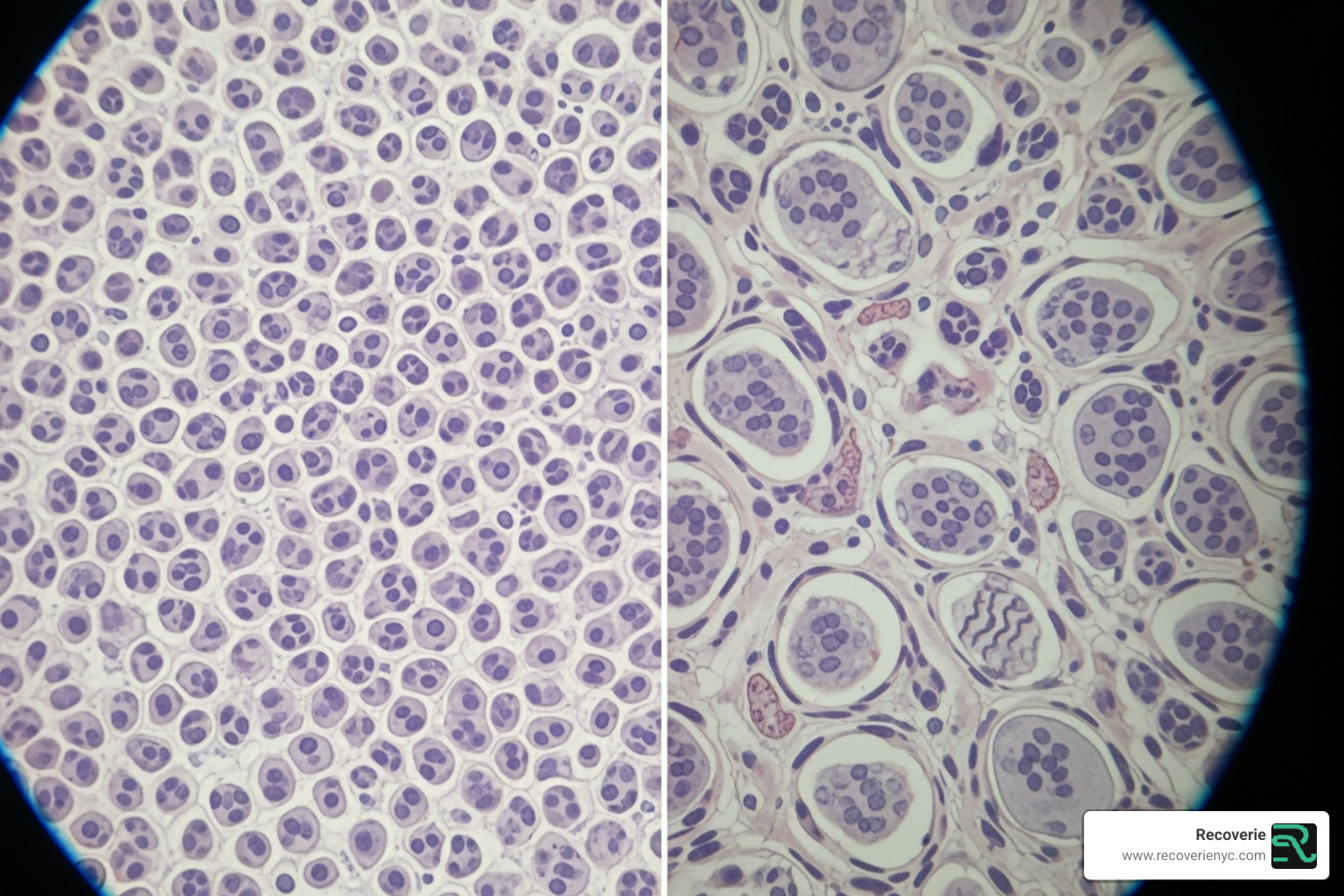
This led experts like Dr. Andrew Huberman to advise waiting 6-8 hours after weight training before an ice bath. While excellent for immediate recovery , timing is crucial for strength goals. However, CWI doesn't seem to negatively affect endurance training, making it great for runners and cyclists.
The Consensus on Key Ice Bath Benefits
Despite some conflicts, there's strong agreement on immediate benefits. Experts like Dr. A. Brion Gardner advocate for them, noting they aid the central nervous system. A systematic review on reducing muscle soreness supports CWI for DOMS. Experts also agree ice baths rapidly lower core body temperature , which is vital for athletes in hot conditions. The psychological edge and feeling of reduced pain make them a valuable tool in elite sports.
Your Guide to Taking the Plunge: Safety, Risks, and Best Practices
While ice bath benefits are enticing, approaching CWI with caution is crucial. Safety is the top priority.
Essential safety tips:
- Always consult a healthcare professional before starting.
- Begin with gradual acclimation to cold temperatures.
- Listen to your body and exit if discomfort becomes extreme.
- Practice controlled breathing to manage the initial shock.
- Have a plan for rewarming immediately after.
- Never plunge alone.
How to Take an Ice Bath Safely
- Ideal Temperature: Aim for 50-59°F (10-15°C). Use a thermometer.
- Recommended Duration: Beginners start with 10-30 seconds. Gradually work up to 2-5 minutes, and eventually the recommended 5-15 minutes. Do not exceed 15 minutes.
- Starting Slow: Acclimatize with cool showers before trying a full bath. Start by immersing only your lower body.
- Technique: Submerge your body as quickly as is comfortable. Focus on slow, deep breaths.
- What to Wear: A swimsuit or light athletic clothing is fine.
- Post-Plunge Protocol: Have warm towels, clothes, and a warm drink ready to rewarm your body immediately.
Potential Risks and Who Should Be Cautious
Be aware of the significant risks.
- Cold Shock Response: Sudden immersion can trigger an involuntary gasp and spikes in heart rate and blood pressure. As the National Center for Cold Water Safety warns , this can be dangerous for those with heart conditions.
- Hypothermia: Staying in too long can cause a dangerous drop in body temperature (below 95°F / 35°C).
- Nerve and Skin Damage: Prolonged exposure can result in ice burn or frostbite.
- Cardiovascular Stress: The practice can be dangerous for individuals with pre-existing cardiovascular disease, high blood pressure, or a history of heart attack or stroke.
- Specific Health Conditions: People with Diabetes , Raynaud's Syndrome , Cold Urticaria , Circulatory Issues , or Open Wounds should be cautious. Certain Medications like beta-blockers can also affect your body's response. Information on body temperature regulation in diabetes emphasizes this risk.
It is paramount to consult a doctor before trying CWI , especially if you have any chronic conditions.
How Ice Baths Compare to Other Recovery Methods
Let's break down how ice bath benefits compare to other popular cold therapy methods.
| Feature | Ice Baths (Cold Water Immersion) | Whole Body Cryotherapy (WBC) | Contrast Therapy |
|---|---|---|---|
| Duration | 5-15 minutes (typically) | 2-3 minutes (typically) | Alternating hot/cold, e.g., 5 min hot, 2 min cold, repeated 3-5 times |
| Temperature | 50-59°F (10-15°C) | -166°F to -220°F (-110°C to -140°C) | Hot: 98-104°F (37-40°C); Cold: 50-59°F (10-15°C) |
| Mechanism | Vasoconstriction, then vasodilation; Hydrostatic pressure | Extreme dry cold; Triggers systemic anti-inflammatory response | "Pump" effect from rapid vasodilation/vasoconstriction |
| Primary Use | Muscle soreness, inflammation, CNS recovery, mood | Systemic inflammation, pain management, athletic recovery | Injury recovery, reduced swelling, improved circulation, muscle soreness |
Ice Baths vs. Whole Body Cryotherapy
Ice baths use wet cold (50-59°F water) for 5-15 minutes. Whole Body Cryotherapy uses dry cold (-166°F to -220°F air) for only 2-3 minutes. The direct contact of water is intense, while many find dry air more tolerable. Ice baths are accessible at home; WBC requires specialized chambers. We offer Whole Body Cryotherapy at our Brooklyn location.
Ice Baths vs. Contrast Therapy
Contrast therapy alternates between hot and cold water. This creates a "pump effect" as blood vessels expand and contract, flushing waste and delivering nutrients. It's excellent for injury recovery and may improve circulation more than cold alone. We also provide Contrast Therapy at Recoverie. The best choice depends on your goals and what feels right for your body.
Is an Ice Bath Right for You?
Are ice bath benefits just for elite athletes? The truth is, the advantages extend far beyond professional sports. The mental resilience, mood boost, and improved recovery are valuable for anyone navigating daily life.
Ice baths are a powerful tool for building physical and mental resilience. Learning to stay calm in the cold trains your nervous system to handle pressure, a skill that carries over into every aspect of your life.
However, safety comes first . If you have heart conditions, high blood pressure, diabetes, or other pre-existing conditions, consult your doctor before starting. Your personal wellness goals also matter. Whether you want to recover faster, boost mental clarity, or build stress resilience, there's a way to safely incorporate cold therapy into your routine.
At Recoverie, our Brooklyn location offers a supportive environment to explore cold therapy safely. Taking the first step can be as simple as a cold shower, or you can use our professional-grade facilities with guidance.
Ready to see how ice bath benefits can fit into your wellness routine? Explore our advanced recovery services and join our community of New Yorkers using cold therapy to recover, reset, and thrive.



